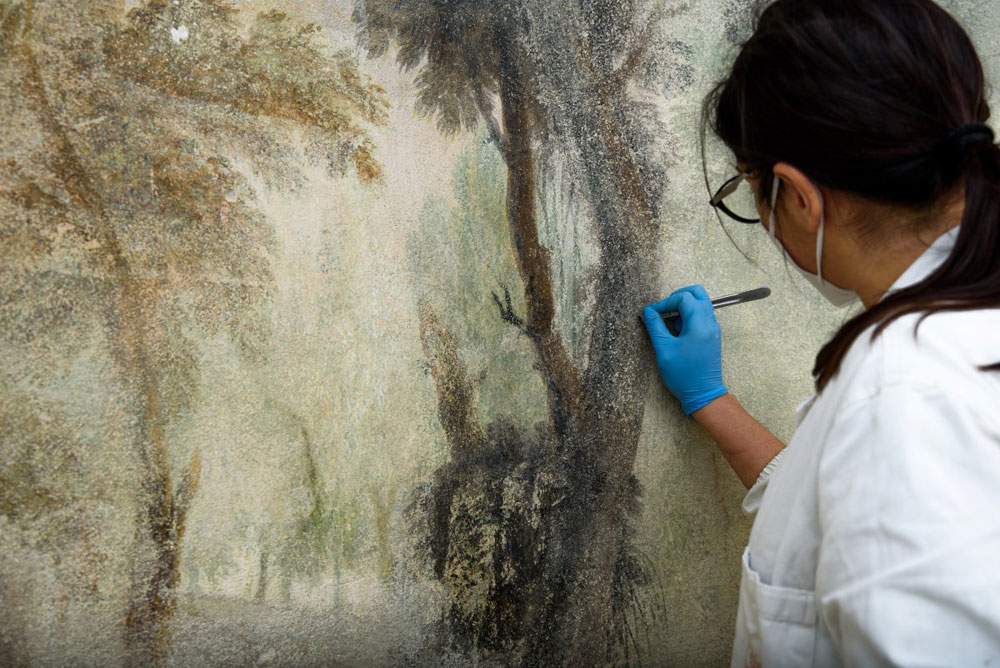Florence, new 19th century wall paintings discovered at Casa Martelli
In Florence, during renovation work on the first floor of Casa Martelli, which is still continuing, valuable paintings and wall decorations dating from the early 19th century were discovered. The rooms where the discovery was made were destined to become an integral part of the museum itinerary, which is why renovation work had been initiated: it was necessary to provide for the improvement of reception, the upgrading of facilities and accessibility of the rooms on the ground floor, and also to provide cafeteria and bookshop services.
The intervention affects eight unused rooms located along Zanetti Street (before the building was transferred to the state in 1999, they were occupied by commercial activities) that remained cluttered with dilapidated furniture and remnants of construction work, with antiquated installations, as well as problems of infiltration and humidity.
Having cleared away the rubble, preliminary cleaning essays were carried out in June 2019 that revealed, under the modern whitewash, the presence of tempera wall paintings on some surfaces. Already at that stage, similarities were found with the paintings in other visitable rooms of Casa Martelli. The pleasant discovery led to a reshaping of the intervention plan: the walls were completely cleared of the white plaster layer, revealing two rooms decorated entirely in landscape from base to ceiling, another illusionistically transformed into a fabric pavilion, and the remaining ones decorated with classical and geometric motifs. Initial research suggests the possibility that these rooms may have been painted in 1809 on the occasion of Niccolò Martelli ’s (1778-1853) wedding to Caterina de’ Ricci to set up the young bride’s summer apartment. Recorded in the archival papers are the names of painters active in the decoration of Tuscan aristocratic palaces and the residences of the kings of Etruria who were also present in other ground rooms and on the second floor of the building: the Pontremolese Niccolò Contestabili (1759 - 1824), who specialized in these highly prized “salons a verzura” of French origin; Gaspero Bargioni (news 1793-1835), an ornament painter enrolled in the Accademia dell’Arte del Disegno; and the “whitewashers” Giovanni and Antonio Ciseri.
Started in October 2020, the descialbo operations are being concluded in these days, allowing to have a general picture of the state of the wall decorations found, the appropriate conservation prescriptions and the compatibility with the intended use. However, in order to have a more detailed historical and artistic picture of what has emerged, it will be necessary to wait for the closure of a special campaign of restoration of the paintings for the aesthetic recovery of the decorations. After that, renovation work that will also lead to the establishment of a cafeteria, a bookshop, an archive and a meeting room can finally be started.
Casa Martelli, which has been part of the Bargello Museums since 2014, has been the residence of an illustrious family in the history of the city and art collecting since the 15th century. Its precious picture gallery, which occupies rooms frescoed by Vincenzo Meucci and Tommaso Gherardini, includes masterpieces by famous artists such as Mino da Fiesole, Piero di Cosimo, Domenico Beccafumi, Salvator Rosa, and Luca Giordano. The palace preserves some striking rooms, decorated entirely in landscape and in imitation of a winter garden, which restore the memory of the life that was led in the house until the family’s extinction in 1986.
Ph.Credit Antonio Viscido
 |
| Florence, new 19th century wall paintings discovered at Casa Martelli |
Warning: the translation into English of the original Italian article was created using automatic tools. We undertake to review all articles, but we do not guarantee the total absence of inaccuracies in the translation due to the program. You can find the original by clicking on the ITA button. If you find any mistake,please contact us.





























